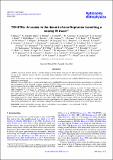| dc.contributor.author | Murgas, F | |
| dc.contributor.author | Astudillo-Defru, N | |
| dc.contributor.author | Bonfils, X | |
| dc.contributor.author | Crossfield, Ian | |
| dc.contributor.author | Almenara, JM | |
| dc.contributor.author | Livingston, J | |
| dc.contributor.author | Stassun, KG | |
| dc.contributor.author | Korth, J | |
| dc.contributor.author | Orell-Miquel, J | |
| dc.contributor.author | Morello, G | |
| dc.contributor.author | Eastman, JD | |
| dc.contributor.author | Lissauer, JJ | |
| dc.contributor.author | Kane, SR | |
| dc.contributor.author | Morales, FY | |
| dc.contributor.author | Werner, MW | |
| dc.contributor.author | Forveille, T | |
| dc.contributor.author | al, et | |
| dc.date.accessioned | 2021-10-27T20:24:13Z | |
| dc.date.available | 2021-10-27T20:24:13Z | |
| dc.date.issued | 2021 | |
| dc.identifier.uri | https://hdl.handle.net/1721.1/135607 | |
| dc.description.abstract | <jats:p><jats:italic>Context.</jats:italic> The NASA mission TESS is currently doing an all-sky survey from space to detect transiting planets around bright stars. As part of the validation process, the most promising planet candidates need to be confirmed and characterized using follow-up observations.</jats:p>
<jats:p><jats:italic>Aims.</jats:italic> In this article, our aim is to confirm the planetary nature of the transiting planet candidate TOI-674b using spectroscopic and photometric observations.</jats:p>
<jats:p><jats:italic>Methods.</jats:italic> We use TESS, <jats:italic>Spitzer</jats:italic>, ground-based light curves, and HARPS spectrograph radial velocity measurements to establish the physical properties of the transiting exoplanet candidate TOI-674b. We perform a joint fit of the light curves and radial velocity time series to measure the mass, radius, and orbital parameters of the candidate.</jats:p>
<jats:p><jats:italic>Results.</jats:italic> We confirm and characterize TOI-674b, a low-density super-Neptune transiting a nearby M dwarf. The host star (TIC 158588995, <jats:italic>V</jats:italic> = 14.2 mag, <jats:italic>J</jats:italic> = 10.3 mag) is characterized by its M2V spectral type with <jats:italic>M</jats:italic><jats:sub>⋆</jats:sub> = 0.420 ± 0.010 <jats:italic>M</jats:italic><jats:sub>⊙</jats:sub>, <jats:italic>R</jats:italic><jats:sub>⋆</jats:sub> = 0.420 ± 0.013 <jats:italic>R</jats:italic><jats:sub>⊙</jats:sub>, and <jats:italic>T</jats:italic><jats:sub>eff</jats:sub> = 3514 ± 57 K; it is located at a distance <jats:italic>d</jats:italic> = 46.16 ± 0.03 pc. Combining the available transit light curves plus radial velocity measurements and jointly fitting a circular orbit model, we find an orbital period of 1.977143 ± 3 × 10<jats:sup>−6</jats:sup> days, a planetary radius of 5.25 ± 0.17 <jats:italic>R</jats:italic><jats:sub>⊕</jats:sub>, and a mass of 23.6 ± 3.3 <jats:italic>M</jats:italic><jats:sub>⊕</jats:sub> implying a mean density of <jats:italic>ρ</jats:italic><jats:sub>p</jats:sub> =0.91 ± 0.15 g cm<jats:sup>−3</jats:sup>. A non-circular orbit model fit delivers similar planetary mass and radius values within the uncertainties. Given the measured planetary radius and mass, TOI-674b is one of the largest and most massive super-Neptune class planets discovered around an M-type star to date. It is found in the Neptunian desert, and is a promising candidate for atmospheric characterization using the <jats:italic>James Webb</jats:italic> Space Telescope.</jats:p> | |
| dc.language.iso | en | |
| dc.publisher | EDP Sciences | |
| dc.relation.isversionof | 10.1051/0004-6361/202140718 | |
| dc.rights | Article is made available in accordance with the publisher's policy and may be subject to US copyright law. Please refer to the publisher's site for terms of use. | |
| dc.source | EDP Sciences | |
| dc.title | TOI-674b: An oasis in the desert of exo-Neptunes transiting a nearby M dwarf | |
| dc.type | Article | |
| dc.contributor.department | Massachusetts Institute of Technology. Department of Physics | |
| dc.contributor.department | MIT Kavli Institute for Astrophysics and Space Research | |
| dc.contributor.department | Massachusetts Institute of Technology. Department of Earth, Atmospheric, and Planetary Sciences | |
| dc.contributor.department | Massachusetts Institute of Technology. Department of Aeronautics and Astronautics | |
| dc.relation.journal | Astronomy and Astrophysics | |
| dc.eprint.version | Final published version | |
| dc.type.uri | http://purl.org/eprint/type/JournalArticle | |
| eprint.status | http://purl.org/eprint/status/PeerReviewed | |
| dc.date.updated | 2021-09-28T17:22:23Z | |
| dspace.orderedauthors | Murgas, F; Astudillo-Defru, N; Bonfils, X; Crossfield, I; Almenara, JM; Livingston, J; Stassun, KG; Korth, J; Orell-Miquel, J; Morello, G; Eastman, JD; Lissauer, JJ; Kane, SR; Morales, FY; Werner, MW; Forveille, T; al, E | |
| dspace.date.submission | 2021-09-28T17:22:24Z | |
| mit.journal.volume | 653 | |
| mit.license | PUBLISHER_POLICY | |
| mit.metadata.status | Authority Work and Publication Information Needed | |
